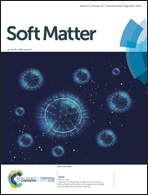Molecular motifs encoding self-assembly of peptide fibers into molecular gels†
Abstract
Peptides are a promising class of gelators, due to their structural simplicity, biocompatibility and versatility. Peptides were synthesized based on four amino acids: leucine, phenylalanine, tyrosine and tryptophan. These peptide gelators, with systematic structural variances in side chain structure and chain length, were investigated using Hansen solubility parameters to clarify molecular features that promote gelation in a wide array of solvents. It is of utmost importance to combine both changes to structural motifs and solvent in simultaneous studies to obtain a global perspective of molecular gelation. It was found that cyclization of symmetric dipeptides, into 2,5-diketopiperazines, drastically altered the gelation ability of the dipeptides. C-L-LL and C-L-YY, which are among the smallest peptide LMOGs reported to date, are robust gelators with a large radius of gelation (13.44 MPa1/2 and 13.90 MPa1/2, respectively), and even outperformed L-FF (5.61 MPa1/2). Interestingly, both linear dipeptides (L-FF and L-LL) gelled similar solvents, yet when cyclized only cyclo-dityrosine was a robust gelator, while cyclo-diphenylalanine was not. Changes in the side chains drastically affected the crystal morphology of the resultant gels. Symmetric cyclo dipeptides of leucine and tyrosine were capable of forming extremely high aspect ratio fibers in numerous solvents, which represent new molecular motifs capable of driving self-assembly.



 Please wait while we load your content...
Please wait while we load your content...